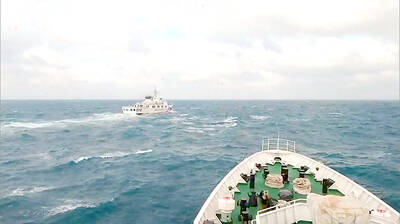The appearance of three cases in Taiwan of an acute form of pneumonia has implicitly exposed the country's isolation from the WHO.
When the three cases of what the WHO is calling "severe acute respiratory syndrome (SARS)" were reported last week, Twu Shiing-jer (
In the WHO's updated report about the SARS outbreak on Sunday, the organization called the disease "an atypical pneumonia of unknown etiology."
Taiwan's first two cases were reported to the Center for Disease Control (CDC) last Friday. The center reported the two cases to the WHO that day, it said.
The center also immediately reported the third case to the WHO after it was discovered on Saturday, it said.
The WHO issued an emergency travel warning regarding the disease on Sunday and an updated report on the outbreak yesterday.
However, when the WHO listed the countries from where it had received reports of SARS cases in its statements, Taiwan was conspicuously absent from the list.
Nevertheless, the center said it had done its best to keep the WHO up to date on the conditions of Taiwan's SARS cases.
Twu said that during his US visit he appealed for the WHO's help in investigating Taiwan's cases.
"The WHO is coordinating the international investigation of this outbreak and is working closely with health authorities in the affected countries to provide epidemiological, clinical and logistical support as required," the WHO's statement on Sunday said.
Although so far the organization has offered Taiwan no direct assistance, two officials from the US Centers for Disease Control and Prevention (USCDC) arrived at Taiwan on Sunday to join the investigation of the cause of the three cases.
On Sunday, Twu expressed disappointment that the WHO did not want to work with Taiwan.
But Chen Tsai-ching (陳再晉), director-general of Taiwan's CDC, said yesterday that the country needed to consider the WHO's dilemma in dealing with such diseases in a non-member state such as Taiwan.
"As long as the WHO has suggested the USCDC send officials to help us, we are very grateful," Chen said.
Hsieh Szu-min (謝思民), an infectious disease specialist from National Taiwan University Hospital, where the first two cases are in quarantine, said the WHO's help would be useful in determining how the two caught the disease.
"As SARS cases have been reported in many countries, transnational cooperation coordinated by the WHO would be more efficient to investigate the cause," Hsieh said.
But Hsieh said he expected a lot from the USCDC officials in examining the cases because "the center is very experienced in investigating unknown agents and viruses."
Hsieh said that over the past few decades, the center had accumulated considerable experience in studying outbreaks and their causes.
DPP lawmaker Lai Ching-te (
"As Taiwan is not a WHO member, it can't join other countries' investigation of SARS cases. It can't obtain first-hand information about the disease from the WHO, either," Lai said.
Taiwan cannot know how many SARS cases there are in other countries immediately, nor can it find out in which areas in the countries these cases were found, Lai said.
"We can't quickly know how these countries treat these cases. We don't know what health policies these countries adopt to contain the spread of the disease," Lai added.
Also See Stories:
Editorial: The Chinese virus invasion
Taiwanese steer clear of Hong Kong

Auckland rang in 2026 with a downtown fireworks display launched from New Zealand’s tallest structure, Sky Tower, making it the first major city to greet the new year at a celebration dampened by rain, while crowds in Taipei braved the elements to watch Taipei 101’s display. South Pacific countries are the first to bid farewell to 2025. Clocks struck midnight in Auckland, with a population of 1.7 million, 18 hours before the famous ball was to drop in New York’s Times Square. The five-minute display involved 3,500 fireworks launched from the 240m Sky Tower. Smaller community events were canceled across New Zealand’s

The Ministry of Foreign Affairs (MOFA) yesterday said it is closely monitoring developments in Venezuela, and would continue to cooperate with democratic allies and work together for regional and global security, stability, and prosperity. The remarks came after the US on Saturday launched a series of airstrikes in Venezuela and kidnapped Venezuelan President Nicolas Maduro, who was later flown to New York along with his wife. The pair face US charges related to drug trafficking and alleged cooperation with gangs designated as terrorist organizations. Maduro has denied the allegations. The ministry said that it is closely monitoring the political and economic situation

‘SLICING METHOD’: In the event of a blockade, the China Coast Guard would intercept Taiwanese ships while its navy would seek to deter foreign intervention China’s military drills around Taiwan this week signaled potential strategies to cut the nation off from energy supplies and foreign military assistance, a US think tank report said. The Chinese People’s Liberation Army (PLA) conducted what it called “Justice Mission 2025” exercises from Monday to Tuesday in five maritime zones and airspace around Taiwan, calling them a warning to “Taiwanese independence” forces. In a report released on Wednesday, the Institute for the Study of War said the exercises effectively simulated blocking shipping routes to major port cities, including Kaohsiung, Keelung and Hualien. Taiwan would be highly vulnerable under such a blockade, because it

UNRELENTING: China attempted cyberattacks on Taiwan’s critical infrastructure 2.63 million times per day last year, up from 1.23 million in 2023, the NSB said China’s cyberarmy has long engaged in cyberattacks against Taiwan’s critical infrastructure, employing diverse and evolving tactics, the National Security Bureau (NSB) said yesterday, adding that cyberattacks on critical energy infrastructure last year increased 10-fold compared with the previous year. The NSB yesterday released a report titled Analysis on China’s Cyber Threats to Taiwan’s Critical Infrastructure in 2025, outlining the number of cyberattacks, major tactics and hacker groups. Taiwan’s national intelligence community identified a large number of cybersecurity incidents last year, the bureau said in a statement. China’s cyberarmy last year launched an average of 2.63 million intrusion attempts per day targeting Taiwan’s critical